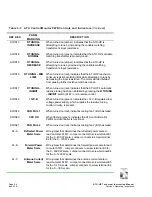
Page 6-2
ATU-HP Technical Instruction Manual
Issue 2.0
Section 6 Theory of Operation
6.2.1.4 Input Voltage and Current Probes
Samples of the input voltage and current,
which are used to determine the ATU-HP’s
input resistance, are applied to the
microcontroller. If the input impedance is less
than 50 ohms, the
Current_ Sample
voltage
will be higher. If the input impedance is
greater than 50 ohms the
Voltage_Sample
voltage will be higher. These relationships
determine the status of the microcontroller
outputs to the increase and decrease R
servo circuits.
6.2.1.5 Microcontroller
The microcontroller controls the movement of
the tuning motors, fan turn-on, and generates
status and alarms. It also provides a serial
data connection which can be remotely
monitored for ATU status information and RF
antenna current level.
6.2.1.6 Antenna Current Probe
The antenna current probe constantly
samples the RF output and produces a signal
that is representative of the mean antenna
current. This signal is applied to switch
A1S11 and can be displayed on the
appropriate scale of meter A1M1. A sample
of the antenna current is also applied to the
microcontroller.
6.2.2 Matching Transformer/Current
Probe
The matching transformer is a wideband
auto-matching transformer which transforms
the sum of the coil loss resistance and
antenna series resistance to the desired
output impedance of the resistive matcher
(which varies depending on frequency).
Selective taps provide a wide selection of
transformer ratios to match a load resistance
of 2.0 to 64.0
Ω
.
6.2.3 Resistive Matcher/Capacitor
PWB
The resistive matcher provides a fine
adjustment for the antenna resistance
(matching transformer is the coarse adjust,
see paragraph 6.2.2) to ensure the
transmitter operates into a 50
Ω
load. The
resistive matcher’s primary and secondary
windings are resonant with the capacitors on
the capacitor PWB, making the resistive
matcher a 1/4-wavelength transformer. The
capacitors are selected to suit the operating
frequency. The position of the resistive
matcher’s inner coil is controlled by a
reversible motor.
6.2.4 Tuning Coils
The tuning coils tune the antenna to the
transmitter’s operating frequency. There are
two tuning coils, which may be connected in
parallel or in series, depending on frequency.
Coarse tuning is provided using selective
taps on each coil. Fine tuning is
accomplished by altering the position of an
inner tuning coil using a reversible motor.
6.2.5 Tuning Drive Motor
The tuning drive motors for the resistive
matcher and the inductive tuning coils are
reversible dc motors that drive a mechanism
to position the inner coil of the resistive
matcher or the tuning coil. Optical limit
detectors inhibit the motors’ electrical circuit if
an end of travel condition is obtained.
















































